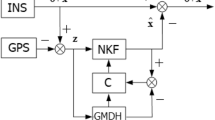Abstract
In this paper the extended H ∞ filtering algorithms for the design of the GPS-based on-board autonomous navigation system for a low earth orbit (LEO) satellite are introduced. The dynamic process models for the estimation of position, velocity and acceleration from the GPS measurements are established. The nominal orbit of the small LEO satellite is determined by using the 7th–8th order Runge—Kutta algorithms. Three filtering approaches are applied to smooth the orbit solutions, respectively, based upon the simulated GPS pseudo range observables using the Satellite Navigation Tool Box. The simulation shows that the observed orbit errors obtained by using the extended H ∞ filtering algorithms can be reduced to a lower level than the observed orbit errors in the sense of RMS within 12 h of tracking time by using the H ∞ filtering algorithms and the extended Kalman filtering algorithms under the appropriately designed parameters. Based upon the position errors predicted by the three filtering algorithms after the last observation, we find that the extended H ∞ filtering algorithm provides the least position errors of the user satellite.
Similar content being viewed by others
References
Balakrishnan, A. V.: 1987, Kalman Filtering Theory, Optimization Software, Inc., Publications Division, New York.
Brown, R. G. and Hwang, P. Y. C.: 1997, Introduction to Random Signals and Applied Kalman Filtering (with Matlab Exercises and Solutions), 3rd edn, Wiley, New York.
Carvalho, H., Del Moral, P., Monin, A. and Salut, G.: 1997, ‘Optimal nonlinear filtering in GPS/INS integration’, IEEE Trans. Aerospace Electron. Syst. 33(3), 835–850.
Einicke, G. A. and White, L. B.: 1999, ‘Robust extended Kalman filtering’, IEEE Trans. Signal Process. 47(9), 2596–2599.
Escobal, P. R.: 1965, Methods of Orbit Determination, Wiley, New York.
Fehlberg, E.: 1968, ‘Classical fifth-, sixth-, seventh-, and eighth-order Runge-Kutta formulas with step-size control’, NASA Technical Rep. TR-R-287.
Feng, Y. M.: 2000, ‘An efficient orbit integrator/filter for GPS-based precise LEO autonomous navigation’, In: Proc. Position Location and Navigation Symposium, IEEE, 2000, pp. 317–324.
Foss, M. and Geier, G. J.: 1996, ‘Integration of GPS with other sensors’, In: E. D. Kaplan (ed.), Understanding GPS: Principles and Applications, Artech House, Boston pp. 385–437.
Hajj, G. A.: 1990, ‘The multipath simulator, a tool toward controlling multipath’, In: Proc. Second Symposium on GPS Applications in Space, Hanscom AFB, MA, February, 1990.
Hofmann-Wellenhof, B., Lichtenegger, H. and Collins, J.: 1997, Global Positioning System: Theory and Practice, Springer Wien, NY.
Hoots, F. R. and Roehrich, R. L.: 1988, ‘Models for Propagation of NORAD Element Sets’, Space Track Report No. 3, Compiled by T. S. Kelso.
Huilet, T. and Salut, G.: 1989, ‘Interpretation des equations du filtrage non-lineaire’, In: Seances du GDR Automatique du CNRS (Ploe non-lineaire), Paris, November 8 (in French).
Irish, K., Gold, K., Born, G., Reichert, A. and Axelrad, P.: 1998, ‘Precise orbit determination for the GEOSAT follow-on satellites’, J. Spacecraft Rockets 35(3), 336–341.
Kaminer, I., Kang, W., Yakimenko, O. and Pascoal, A.: 2001, ‘Application of filtering to navigation system design using passive sensors’, IEEE Trans. Aerospace Electron. Syst. 37(1), 158–172.
Kaplan, E. D., Leva, J. L. and Pavloff, M. S.: 1996, ‘Fundamentals of satellite navigation’, In: E. D. Kaplan (ed.), Understanding GPS: Principles and Applications, Artech House, Boston.
Khargonekar, P. P. and Rotea, M. A.: 1991, ‘Mixed H 2/H ? control: a convex optimization approach’, IEEE Trans. Automatic Contr. 36(7), 824–837.
Khargonekar, P. P. and Rotea, M. A.: 1992, ‘Mixed H 2/H ? filtering’, In: Proc. 31st Symposium on Decision and Control, Tucson, AZ, December 1992, pp. 2299–2304.
Kirubarajan, T., Bar-Shalom, Y., Pattipati, K. R. and Kadar, I.: 2000, ‘Ground target tracking with variable structure IMM estimator’, IEEE Trans. Aerospace Electron. Syst. 36(1), 26–46.
Kuang, J. L. and Tan S. H.: 2002, ‘GPS-based attitude determination of gyrostat satellites by quaternion estimation algorithms’, Acta Astronaut. 51(11), 743–759.
Leick, A.: 1995, GPS Satellite Surveying 2nd edn, Wiley, New York.
Leva, J. L.: 1996, ‘An alternative closed-form solution to the GPS pseudo-range equations’, IEEE Trans. Aerospace Electron. Syst. 32(4), 1430–1439.
Limebeer, D. J. N., Green, M. and Walker, D.: 1989, ‘Discrete-time H ? control’, In: Proc. 28th IEEE Conference on Decision and Control, Tampa, FL, Vol. 1, pp. 292–396.
Misra, P., Burke, B. P. and Pratt, M. M.: 1999, ‘GPS performance in navigation’, In: Proc. IEEE 87(1), 65–85.
Nagpal, K. M. and Khargonekar, P. P.: 1991, ‘Filtering and smoothing in an H ? setting’, IEEE Trans. Automatic Contr. 36(2), 132–166.
Pascoal, A., Kaminer, I. and Oliveira, P., 2000, ‘Navigation system design using time-varying complementary filters’, IEEE Trans. Aerospace Electron. Syst. 36(4), 1099–1114.
Pervan, B. S., Lawrence, D. G. and Parkinson, B.W.: 1998, ‘Autonomous fault detection and removal using GPS carrier phase’, IEEE Trans. Aerospace Electron. Syst. 34(3), 897–906.
Press, W. H., Teukolsky, S. A., Vetterling, W. T. and Flannery, B. P.: 2002, Numerical Recipes in C++: The Art of Scientific Computing, 2nd edn (Hardcover), Cambridge University Press, Cambridge.
Rimrott, F. P. J.: 1989, Introductory Orbit Dynamics, Vieweg.
Satellite Navigation Tool Box 2.0 for Matlab User's Guide, October 1999, GPSoft LLC, Princeton Satellite Systems, Inc., 33 Witherspoon Street, Princeton, NJ, 08542.
Sayed, A. H.: 2001, ‘A framework for state-space estimation with uncertain models’, IEEE Trans. Automatic Contr. 46(7), 998–1013.
Vallado, D. A.: 1997, Fundamentals of Astrodynamics and Applications, College Custom Series, McGraw-Hill, New York.
van Loan, C. F.: 1978, ‘Computing integrals involving the matrix exponential’, IEEE Trans. Automatic Contr. AC-23(3), 395–404.
Webb, F. and Zumberge, J.: 1995, An Introduction to GIPSY-OASIS II, JPL D-11088.
Xie, L., Soh, Y. C. and de Souza, C. E.: 1994, ‘Robust Kalman filtering for uncertain discrete-time systems’, IEEE Trans. Automatic Contr. 39(6), 1310–1314.
Yunck, T. P.: 1996, ‘Orbit determination’, In: B. W. Parkinson (ed.), Global Positioning System: Theory and Applications, Vol. 2, Chapter 21 AIAA, Washington, DC, pp. 559–592.
Author information
Authors and Affiliations
Rights and permissions
About this article
Cite this article
Kuang, J., Tan, S. & Wang, Y. GPS-Based On-Board Orbit Determination of a Satellite Using Extended H ∞ Filtering Algorithms. Celestial Mechanics and Dynamical Astronomy 88, 103–122 (2004). https://doi.org/10.1023/B:CELE.0000016808.94028.f0
Issue Date:
DOI: https://doi.org/10.1023/B:CELE.0000016808.94028.f0




